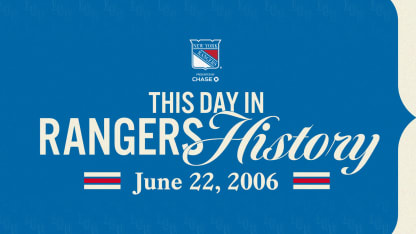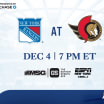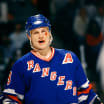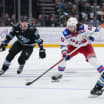As the Rangers franchise enters its Centennial season in 2025-26, their five all-time leaders in points might appear obvious. Rod Gilbert, Brian Leetch, Jean Ratelle, Andy Bathgate, and Mark Messier are all Hockey Hall of Famers who left indelible legacies during their tenures with the Blueshirts.
The player who ranks sixth on the Rangers’ all-time points list – just 13 points behind Messier – is Walt Tkaczuk. While Tkaczuk’s ranking on the franchise’s scoring list – as well as his ranking on several other franchise lists – illustrates part of his legacy, the impact he had on the Rangers teams he played on went far beyond his statistics.
Tkaczuk was born in Emsdetten, Germany in 1947, and his family emigrated to Canada when he was two years old. When Tkaczuk was 13 years old, he was spotted by Rangers scout Lou Passador, and just a few years later, he was playing for Kitchener – a junior team the Rangers had a working agreement with at the time – in the Ontario Hockey Association. He quickly emerged as one of the top players in the league, and in 1967-68, he was named the OHA’s Most Outstanding Player.
It was also during the 1967-68 season that Tkaczuk (which was initially pronounced as “Tay-chuck” before being corrected to “Ka-chook” early in his career) made his NHL debut with the Rangers, as he was called up for two games in January 1968. On June 24, 1968, he signed his first NHL contract with the Rangers, and he nearly made the opening night roster out of training camp. After just five games with the Buffalo Bisons in the American Hockey League – in which he tallied nine points – Tkaczuk was recalled by the Rangers, and he never looked back.
Tkaczuk was one of two rookies who made the Blueshirts a more formidable team in 1968-69, along with Brad Park. The two players struck up a strong friendship – one that continues to this day – and lived together in New York. As they improved, so too did the Rangers’ fortunes.
In his second full season with the Blueshirts in 1969-70, Tkaczuk not only had the best statistical season of his NHL career, but he also carved out his role on the team. That season, he led the Blueshirts with 77 points and 50 assists, was named the team’s Most Valuable Player, and was selected to play in the NHL All-Star Game. In addition, after Tkaczuk was put on a line with left wing Dave Balon and right wing Bill Fairbairn, the trio became known as the “Bulldog Line” for their combination of size, skating ability, and tenacity.
As the center of the second line and playing behind the “G-A-G Line” of Vic Hadfield, Jean Ratelle, and Rod Gilbert, Tkaczuk didn’t receive as much notoriety as the legendary trio. But the impact he made on those Rangers teams throughout the early and mid-1970s was not underappreciated by the teammates he played with and the coaches he played for. And it was not limited to how many goals he scored or set up.
“It’s my feeling that Walt is one of the most underrated players in the league,” Emile Francis, the Rangers’ head coach and general manager for most of Tkaczuk’s tenure with the team, said about him. “He does just about everything well, is a fine team man, and always comes through with steady play.”
One of the stronger players in the NHL during his era, Tkaczuk was an exceptional two-way forward who excelled on the penalty kill. During the 1971-72 season – in which the Rangers advanced to the Stanley Cup Final – perhaps Tkaczuk’s most memorable game wasn’t the one in which he became the first Ranger to have five assists in a single game on February 12, 1972, or one of his four consecutive multi-point contests in January, but rather the Blueshirts’ contest in Los Angeles on January 19, 1972. Tkaczuk only had one point in that game, but during one sequence when the Rangers were killing a penalty, he – along with Fairbairn, Jim Neilson, and Rod Seiling – prevented the Kings from touching the puck for approximately 80 seconds.
Francis said after the game that the penalty killing exhibition the team put on was, “the finest display of defensive hockey I’ve seen in all my years.”
Tkaczuk’s defensive prowess was also on display during the 1972 Stanley Cup Final against the Boston Bruins. The “Bulldog Line” was primarily matched up against Phil Esposito’s line, and Tkaczuk held the Bruins’ center – who led the NHL with 66 goals during the 1971-72 season and had nine through nine playoff games in the first two rounds of the playoffs – without a goal in the six-game series.
Had the Selke Trophy – which has been awarded annually since 1977-78 to “the forward who best excels in the defensive aspects of the game” – been in existence during the first half of Tkaczuk’s career, there were several seasons in which he would have certainly warranted consideration for the award. Over a four-season stretch from 1969-70 through 1972-73, Tkaczuk averaged 71 points and a plus-28 rating while helping the Rangers post a penalty kill percentage above 83.8% each season.
As the 1970s progressed, the Rangers made several changes to their roster and front office, but Tkaczuk was the one constant. In 1972-73, Steve Vickers joined the Rangers and won the Calder Trophy as the NHL’s Rookie of the Year. As Vickers said about Tkaczuk years later, “When I was getting all my goals, I was getting the glory while he was doing a lot of the work.” In 1977-78, Tkaczuk was once again named the team’s Most Valuable Player, as he registered 66 points and a plus-15 rating while helping a retooled Blueshirts team return to the Stanley Cup Playoffs after a two-year absence.
The following season, the Rangers advanced to the Stanley Cup Final. Tkaczuk – who recorded 42 points and a plus-19 rating during the regular season before registering 11 points and a plus-eight rating in 18 playoff contests – was the player on the team that advanced to the Stanley Cup Final in 1972 who was also a member of the team that played in the Stanley Cup Final in 1979.
Prior to the 1980-81 season, the Rangers organization decided to have three players share the captaincy for that season – Dave Maloney, Tkaczuk, and Barry Beck. Tkaczuk began his tenure as the Blueshirts’ captain on December 7, 1980, but in his 20th game with the “C” on February 2, 1981, against Los Angeles at MSG, a deflected puck hit him just above his right eye, which caused bleeding around his retina. As a result of the injury, Tkaczuk never played in another NHL game.
Tkaczuk finished his career with 945 career regular season games played as a Ranger; only Harry Howell, Leetch, Gilbert, and Ron Greschner have played in more. Tkaczuk’s 93 career playoff games played with the Blueshirts were the most in franchise history at the time of his retirement and have only been surpassed by some familiar names in recent years – Henrik Lundqvist, Dan Girardi, Ryan McDonagh, Derek Stepan, Marc Staal, and Chris Kreider. His plus-184 rating remains the best in Rangers history, while his 441 career assists are the fifth-most.
Through parts of 14 NHL seasons – all with the Rangers – Walt Tkaczuk was the reliable center who did whatever it took to help his team win.






















